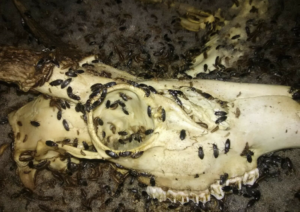When you want to display your trophy game head as a European skull mount, there are several different methods you could use to remove the flesh. You may even have heard of your friends telling you about the horrors they experienced using certain methods or the painstaking time it took to clean the skull.
If you want to avoid making the same mistakes as others and are looking for an effective way to get the best and most aesthetically pleasing skull cleaning results, then you will want to use dermestid beetles.
Methods of Skull Cleaning
To understand why dermestid beetles are your best choice, we need to look at the different methods of skull cleaning. Keep in mind, we are only sharing an overview of these methods and the reasons why we do not recommend them. It is entirely up to you to decide how to clean your game skulls, but we feel it important you understand the risks of using other methods.
Simmer Boiling
You could take the game skull and toss it into a pot of water you simmer-boil for hours on end and wait for the flesh to soften and fall off. While this might seem like a great way to remove the flesh, it has its drawbacks.
Any fat in the flesh can be absorbed by the bone structures of the skull. What you end up with is yellowing of the bone. In addition, if you do not simmer the skull carefully, the skull bones could come apart.
Simmer boiling does not remove all of the flesh from each area. You will still need to use various tools to remove any remaining flesh. These tools can leave scrapes and other noticeable imperfections in the skull.
Skull Soaking
This method is where you take the game skull and place it into a pot of room temperature water. You put a lid on the pot and leave the skull sitting for days or even weeks, depending on its size. The problem with this method is that the flesh will continue to decay while it is soaking in the water.
As soon as you open the lid, you will be greeted by a host of foul and unpleasant odors. The water will turn icky too. Then you have to worry about bacteria and algae growth. You will also need to change the water frequently throughout this process.
Additionally, once the flesh has soaked and softened, you will still need to remove it by hand. During the removal process, it is easy for small nasal bones and other small skull bones to accidentally be ripped off.
Any remaining bits of flesh have to be removed manually using various tools. Just like with simmer boiling, you can scrape and damage the bone when using these tools.
Furthermore, if algae develop, they can discolor any exposed bone, turning it a greenish tinge. Not to mention, the bones can feel greasy from the animal fat as it breaks down and sticks to the bones.
Flesh Removal Using Chemicals
Chemicals might seem like the perfect solution to remove flesh to create your European skull mount. However, the problem with chemicals is they can be corrosive and toxic and smell really bad. Many of these chemicals have health hazards and risks if not handled correctly using the right safety equipment. You’ll have to be careful where you eventually dispose of them.
Additionally, certain chemicals can soften the bone and make it flimsy and bendable. Other chemicals will not only eat away the flesh but also delicate boney structures. Even still, some chemicals dissolve bone if they are left soaking in them too long.
Natural Flesh Removal
Another option some hunters use to remove the flesh from their game skulls is burying them in the ground. While the process is most certainly natural, it does take time—sometimes up to a year! During this time, there are all sorts of risks because the environment is not controlled.
Dogs and other predatory animals could dig up the skull and carry it off. Certain insects could also damage the skull, especially if they can burrow into the bone. The bones in the skull can also start to degrade from changes in moisture and dryness in the ground.
What Are Dermestid Beetles?

Who Uses Dermestid Beetles to Clean and Preserve Animal Skulls and Bones?
You may have seen dermestid beetles featured on your favorite crime drama series like Bones. In fact, forensic scientists, museums, anthropologists, biologists, and professional taxidermists have been using these flesh-eating beetles for ages. They offer a safe and effective way to remove flesh from dead animals—and even humans, in the case of murder investigations—while preserving the bone and any related evidence.
Why Dermestid Beetles Are the Best Choice for Skull Cleaning
The thought of using flesh-eating beetles to clean skull and bones might seem like they would devour everything that was not solid bone, such as delicate nasal bones. However, you would be surprised that while these beetles have a huge appetite for dead flesh, they do not touch any type of bone whatsoever.
It is this natural marvel that leaves the delicate boney structures of skulls intact for a superior-looking European skull mount. If you attempt to use one of the other methods we discussed earlier, these delicate boney structures will be removed or damaged in the process.
Another reason dermestid beetles are the best choice for skull cleaning is they do not discolor the skull. Their job is to remove all flesh from the skull. This includes any fat, meat, hair, and muscle. Once the beetles finish their job, you are left with the most natural-looking skull to use for your European mount.
How Hard Is It to Get Dermestid Beetles for DIY Skull Cleaning?
Sourcing dermestid beetles for your own DIY skull cleaning is not difficult at all. You can order a starter colony of beetles directly from us. Even though you might find these beetles for sale elsewhere, the colony may not be 100% healthy. If fly larvae, mites, or other pests and insects are allowed to invade the beetle colony, they can kill it off before the beetles have a chance to flourish.
This is why it is important to source your dermestid beetles from a reputable dealer that offers 100% healthy colonies. Equally important is finding a supplier that is there to provide support, both in helping answer questions you have about how many beetles to order to being there after the sale when questions arise about caring for your colony.
How Hard Is It to Start a Dermestid Beetle Colony?
With the right materials and supplies, it is easy to set up your own dermestid beetle colony at home. Raising dermestid beetles is fun and educational too. A basic colony requires a small reptile or fish tank, substrate, Styrofoam, a screened lid, and a heating pad. You will also need a source of food for your beetles in between skull cleaning sessions, such as dried fish heads or meat scraps.
How Many Dermestid Beetles Do I Need to Clean Big Game Skulls?
For big game skulls, you want an established colony of around 1,000 beetles or more. However, if you have a starter colony of around 300 beetles, they can still do the job, but it will take slightly longer to complete.
If you are looking to get into full-scale skull cleaning production for yourself and your hunting friends, then you will need a colony of at least 5000 or more dermestid beetles.
You can either start with a starter colony and grow it larger yourself or order a larger number of beetles for your starter colony. We recommend starting with a smaller colony to get familiar with caring for your beetles, and then adding more once you are more comfortable. No matter what you decide, we are happy to provide ongoing support to answer questions and offer our expert advice.
What If I Don’t Have Time to Raise a Dermestid Beetle Colony?

For further information about dermestid beetles, ordering a colony, or shipping your skulls to use for our taxidermy skull cleaning service, or any other questions, please feel free to contact Kodiak Bones & Bugs Taxidermy using our online submission form or calling 907-942-2487 today!

